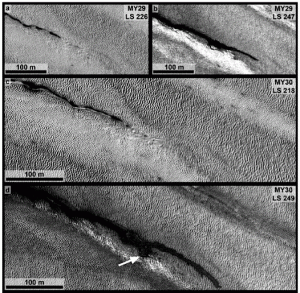Images from the HiRISE camera on NASA’s Mars Reconnaissance Orbiter have captured the first visible evidence for seasonal changes in gullies on slopes in the south polar region of Mars.

CHANGES over two Mars years (MY 29 and 30) as dark material travels down a high-latitude southern gully. Mars year 29 began December 2007, Mars year 30 began October 2009. Martian seasons are denoted by the Sun's longitude (LS), with southern spring beginning at LS = 180. (Image taken from Figure 1 in the paper.)
Giving a report (PDF) at the 43rd Lunar and Planetary Science Conference in The Woodlands, Texas, a team of scientists led by Jan Raack (Westfälische Wilhelms-Universität, Germany) says they spotted seasonal activity in gullies within the last two Martian years on slopes of a polar pit. The pit is about 1,000 meters (3,200 feet) deep and lies in a filled crater about 54 km (33 miles) wide, lying north of Sisyphi Cavi at 68.5° south and 1.5° east.
The team suggests that the source material of the gullies appears to be relatively fine grained sediments mixed with boulders about 5 m (17 ft) in diameter. Seasonal activity has been seen before in the polar regions, they note, adding that their research focuses on the exact timing for changes in gullies, and on the possible medium and mechanism driving gully activity.
The HiRISE images showed new small deposits appearing on the gully apron and dark material travelling down gully channels, although the team saw no erosion in the gully alcoves or channels.
Carbon dioxide ice lingered in the region into local spring, then disappeared as temperatures rose from about –93° C (–135° F) to –33° (–27° F), causing the CO2 ice to sublimate into the atmosphere. After the CO2 ice was gone the changes stopped. This led the researchers to conclude, “Sublimating of CO2 is the most likely candidate to initiate these changes, but involvement of small amounts of H2O brines can not be ruled out.”








